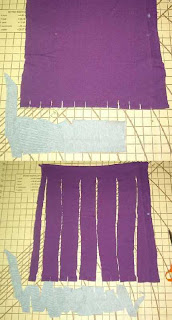How to Spiral-Cut a T-Shirt
If you're looking for ways to embellish a t-shirt by cutting it, here are a couple of books on the subject:
99 Ways to Cut, Sew, Trim, & Tie Your T-Shirt, by Faith Blakeney and Generation T: 108 Ways to Transform a T-Shirt
by Megan Nicolay.
 But if you want to know how to get yards of yarn from an old t-shirt . . .
But if you want to know how to get yards of yarn from an old t-shirt . . .
I finally decided my old purple t-shirt had had it, and that it was time to spiral-cut it into a long strip and add it to my knitted t-shirt-rag rug. The last time I mentioned this on a knitting list, I got questions about how I cut the strips, so I took pictures as I cut this one up.
It's very easy to do, but not so easy to describe without pictures.
You can also spiral-cut a sock. Even a crew sock yields a strip over three yards long. I use the strips for weaving rag rugs on my floor loom, and the all-cotton ones for weaving potholders on my little metal potholder loom. It can be hard to find all-cotton loopers, and a potholder made out of polyester loopers isn't safe -- it can melt and burn you.
I use a t-shirt with no side seams, just a straight tube. You can use shirts with side seams, but the seams are lumpy. Lay the shirt flat and cut it across just below the arms. If you are spiral-cutting a sock, cut the heel out and lay the sock flat.
Starting at the bottom, make short cuts as wide as you want your strips. If you don't have a cutting board, any big piece of cardboard will do. For years I used a piece of box cardboard. I used the groove where the box had been folded as a cutting guide, to help me cut roughly straight.
Cut towards the opposite edge, but STOP! about two inches before you get to the edge, otherwise you will just have a set of giant loopers. You will have a sort of fringe of dangling cut pieces, held together at the edge.
Now each of your cuts will be diagonals. You can see the first cut in the t-shirt going diagonally to the left edge. After that, you keep cutting diagonals: from the bottom left, cut up to the top left. This will make one long continuous strip.
After all of the diagonal cuts are made, the last step is to stretch the whole cut strip. Since it's made from a knitted t-shirt, this makes it curl up with the purl side out. It also rolls the cut edge up. I stretch the whole length, usually twice. Sometimes I throw it in the laundry in a lingerie bag after I cut and stretch it.
T-shirt material doesn't make too much mess, but socks will leave lots of little bits all over everything, including in the laundry.
I am adding mine to a t-shirt rag rug, knitted in garter stitch on a US size 13 circular knitting needle. This is going to be a heavy rug, the kind that only dries in full July sunshine, or in front of a hot woodstove. It will be perfect for our bathroom floor, the coldest floor in the house.
I can knit about one row at a time on this before my hands scream at me to go knit something lighter.
Edited to add:
If you go to the On-Line Digital Archive of Documents on Weaving and Related Topics and look under monographs, you will find a 1.4 Mb PDF file of a 1988 typewritten booklet by Karen Madigan of Australia called T-Shirt Yarns: How to Recycle T-Shirts, Etc..
Direct link to the 1.4 Mb PDF file
I never saw this booklet before I stumbled across it at the On-Line Digital Archive just now (April 2010), but in 1988 I was doing a lot of weaving, some of it with t-shirt yarn!
Labels: fun with t-shirts, knitting, t-yarn, tarn









7 Comments:
Found you via the Thrifty Knitters group on Ravelry.com
This tutorial is wonderfully helpful and detailed. Photos clearly illustrate the steps. Many thanks!
Thanks for this. :) I have a giant stack of old t-shirts crying out for repurpsing. :)
BTW, I also found you from the Thrifty knitters group on Ravelry.
Thanks for the instructions. This is something that I can do with the stained t-shirts I have that Goodwill won't take!
I have a bunch of t-shirts from my kids that are stained. Instead of trashing them, I'm going to make rag rugs out of them. Thanks for the tutorial!
PS: I'm from Ravelry, too.
thanks... came here from ravelry as well!
GREAT instructions!
I understand almost all of them (heee!) with the exception of the this statement: "After you have made all your cuts almost all the way across, open up the uncut edge and put something inside it. A newspaper, a kid's book, a sheet of typing paper, cardboard, whatever is handy." What is the purpose of putting something inside the uncut edge? And I don't see a photo that shows that. Can you clarify for me, please! Thanks so much!
In the bottom of the third photo, I have a piece of cardboard in there.
At that point, the shirt is still a big tube. The cardboard is so that I can make the last cuts without nicking or cutting through the strips.
That is, it's just to keep from accidentally cutting anything I don't mean to cut.
Post a Comment
<< Home